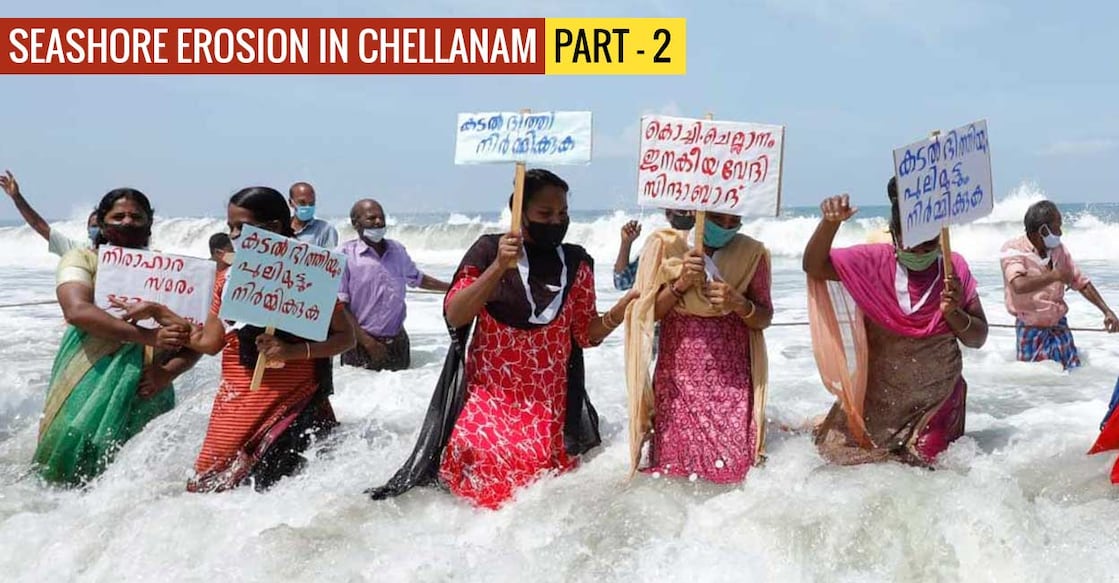Hit hard by coastal erosion, Chellanam residents say enough is enough | Watch Video

Mail This Article
Editor’s Note: This is the second of a five-part text & video story series exploring in depth the coastal erosion in Chellanam in Kerala’s Ernakulam district. Read the first part here.
More than 15,000 people living on the 17.5km coastal stretch in Chellanam live under seashore erosion threat almost round the year. The situation worsens when southwest monsoon lashes the coast (between June and August), and during the formation of cyclonic storms in the Arabian Sea.
The sea turns turbulent during this period and monster waves breach the already-damaged sea wall. The waves even drive corroded rocks from the sea wall and destroy houses.
The latest cyclone to bring misery to the village was Taukate.
Formed in the Arabian Sea in May, the cyclone caused floods and destroyed three houses. Hundreds of people were shifted to the relief camps opened at the St Mary’s Higher Secondary School.
Most of them returned to their homes after flood waters receded three days later.
But nine persons from two families still could not move back because the seashore erosion had brought their houses down.
Elsy’s six-member family – her husband Antony, son Biju, daughter-in-law Nyshi and grandchildren Adarsh and Ameya – lives in one class room.
Next to them lives Thankamma’s three-member family – her husband Antony Machingal and son Shinoy.

Like in the camp, both families lived in adjacent houses in the Bazaar area of Chellanam.
The government officials had asked them to vacate their homes and head to the school when huge waves began to pound the coast on May 13. “My husband has difficulty walking long distances. So we started immediately leaving all our possessions at home. After taking us to the school, our son went to check the condition of the house. By that time it had collapsed completely,” Elsy recounted.
She thanks the gram panchayat officials for providing them food all these months, but what worries her is the uncertainty of relocating to a new home. “How long can we live in this classroom? We need a home. The sea has devoured our land. So we have to buy land and build a new house. Otherwise we will be forced to live in this classroom,” she said.
Elsy’s son Biju is searching for land in Chellanam and nearby areas. The family harps on the government’s financial assistance of Rs 10 lakh under the Punargeham project, which was launched in 2019 to relocate close to 20,000 families from coastal villages across Kerala. So far the government has built 3,000 homes. Under the project, the government will provide Rs 6 lakh to buy land and Rs 4 lakh to build homes.
But Elsy is uncertain whether she will be able to buy high-priced land in Chellanam. “Rs 10 lakh is inadequate to find land and build a house. If we do not get a place in Chellanam, we will move to neighbouring Alappuzha district,” she said.
Thankamma’s collapsed house was constructed six years ago availing loans for Rs 7.5 lakh from various financial institutions. The family still has to repay Rs 2.5 lakh. Her 61-year-old husband is unable to work regularly and her 26-year-old son has just begun to work. That is why she feels a new house is an unrealistic dream. “We cannot dream of a house on our own. We do not want to leave Chellanam. But we will have to if we fail to get a shelter here,” she said.
Chellanam residents had faced a similar frightening situation in 2017 when waves smashed the coast in the wake of Cyclone Ockhi. It had killed two people in the village and rendered many people homeless.
Residents angry
Government’s inability to find a solution to sea erosion has angered the residents. Little wonder, then, that Chellanam is witnessing many protests these days.
The protests organised by Chellanam-Kochi Janakeeya Vedi (People’s Forum) have crossed 650th day recently. It staged many innovative protests such as Jala Samadhi (water grave) and relay hunger strikes. The latest in the series was the ‘Sleeping Protest’ in front of the Fisheries Deputy Director’s Office in Ernakulam on August 2.

Advocate Thushar Nirmal Sarathy, one of the organisers of the People’s Forum, said empty promises of the successive governments have forced Chellanam residents to organise protests. “After the devastation caused by Cyclone Ockhi in 2017, the government had promised to build sea wall using geotube, but the promise did not materialise. The Chellanam-Kochi Janakeeya Vedi was formed after the severe coastal erosion in 2019. We have been organising various protests since then,” he said.
Chellanam resident and patron of the forum, V T Sebastien said people will not withdraw their agitation until the government finds a permanent solution to the crisis. “We will not budge till then,” he said.
The Kerala Regional Latin Catholic Council, an umbrella organisation of the Latin Christians who form 75 per cent of the population in the region, has formed a platform, Care Chellanam, to force the government to take measures to protect the coast.

Fr John Kandathil Parambil, vicar of the Velankanny Church, is the coordinator of the outfit. “This is formed jointly by the Alappuzha and Kochi Dioceses of the Latin Christian Church. Priests and laity are members of the outfit,” he said.
He said Care Chellanam wants to ensure permanent safety to the coast. “We are trying to influence the government to achieve our aim,” he said.
(To be continued)
Part - 3 (Text & Video): What Causes Coastal Erosion In Chellanam?


